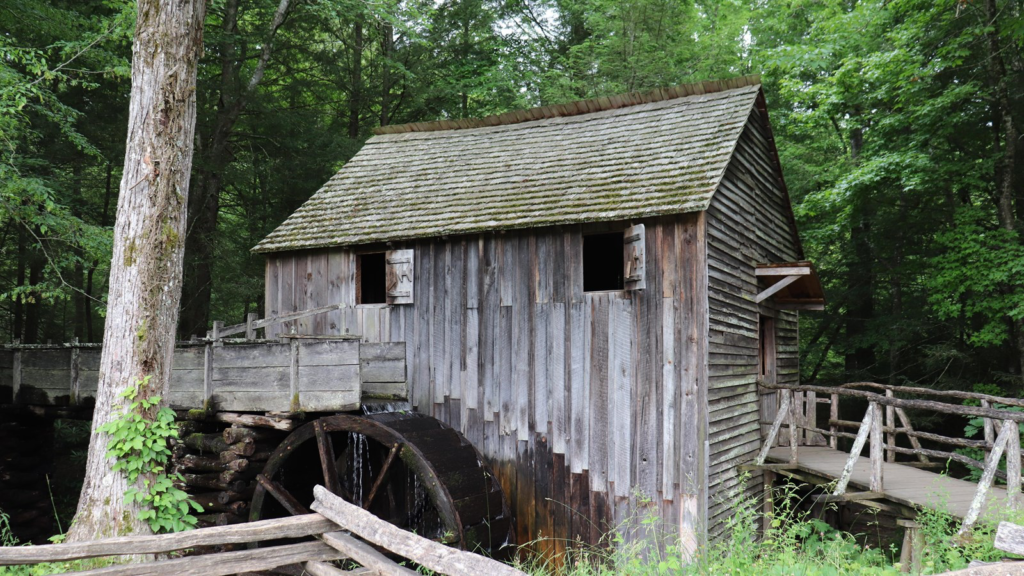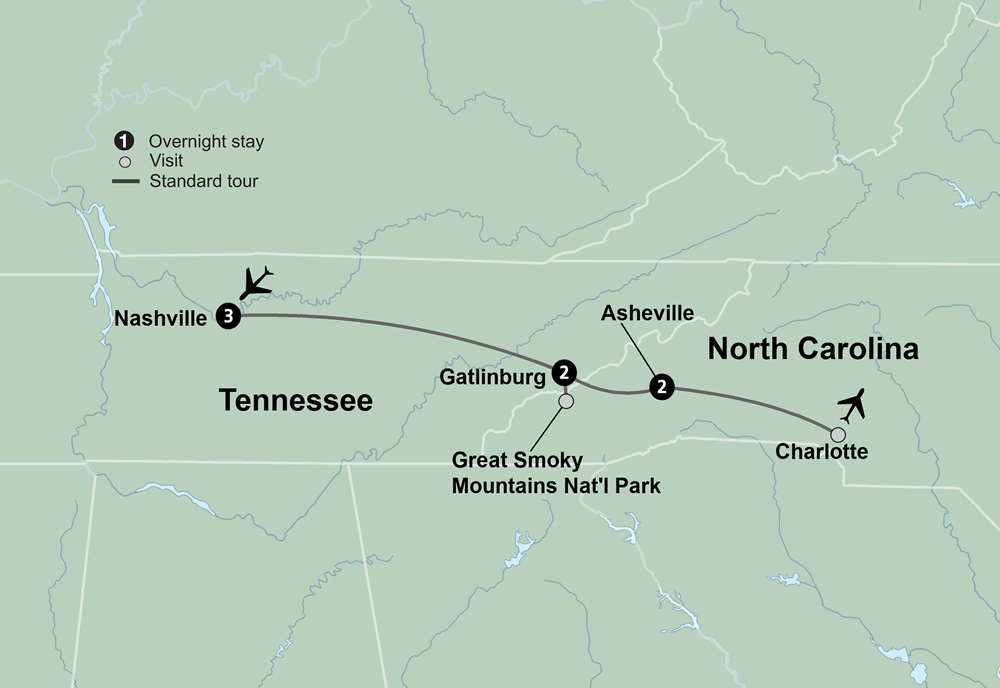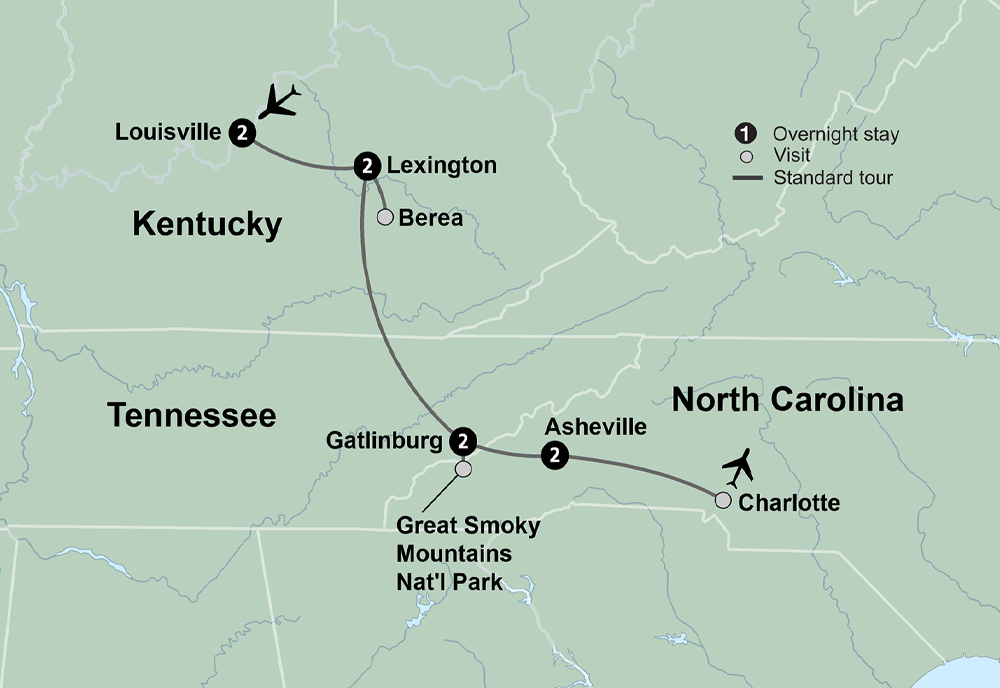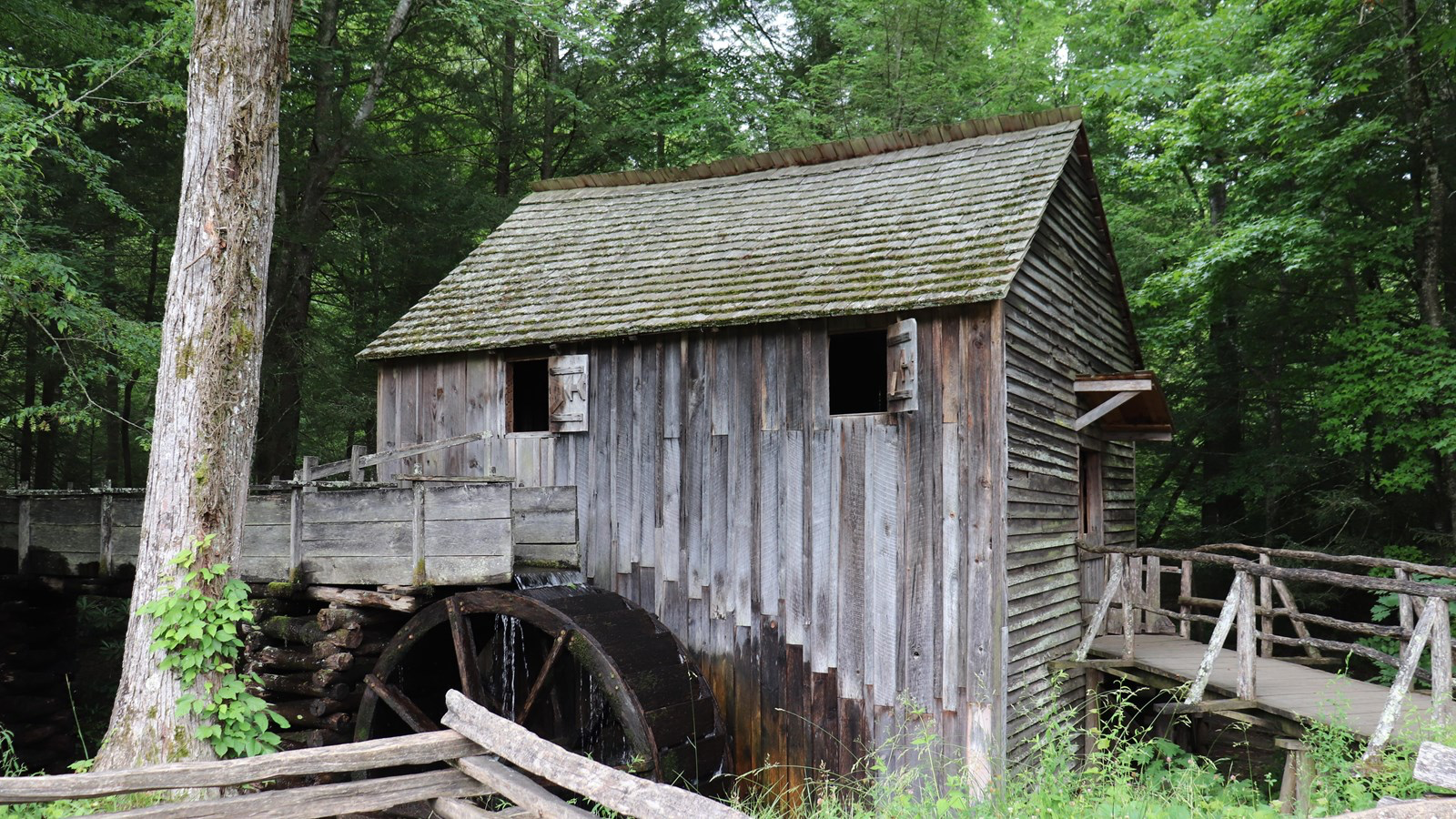Howdy folks, Ethan Taylor here, your Smoky Mountain storyteller! Today, we’re setting off on a journey through time to explore a fascinating relic nestled amidst the verdant expanse of the Great Smoky Mountains National Park – the Cable Mill in Cades Cove. This isn’t just any ordinary landmark; it’s a portal to a bygone era, where the rhythm of life danced to the tune of clanking gears and waterwheel churn.

Cable Mill Cades Cove stands as a testament to human ingenuity and its profound impact on a community. Built around 1870 by John P. Cable, this gristmill served as the cornerstone of Cades Cove’s food production. Imagine a time when folks brought their corn and wheat harvests to the Cable Mill, eagerly awaiting their transformation into the flour that would grace their tables. The Cable Mill Cades Cove wasn’t just about sustenance; it was the center of a vibrant social scene. Folks would gather around the mill, sharing stories, catching up on news, and forging connections that strengthened the community’s spirit.
But Cable Mill Cades Cove’s significance extends far beyond flour and friendly faces. This ingenious contraption revolutionized construction methods in Cades Cove. Intrigued? Buckle up, because we’re about to delve into the fascinating world of the Cable Mill Cades Cove, where history whispers from every stone and the echoes of a bygone era bring the past vividly to life.
A Mill for All Seasons: The Multifaceted Importance of Cable Mill
The Cable Mill in Cades Cove wasn’t just a one-trick pony, churning out flour for hungry bellies. This industrious marvel had a far-reaching impact on the community, influencing everything from their daily meals to the very structure of their homes. Let’s delve deeper and explore the multifaceted importance of the Cable Mill Cades Cove, uncovering the fascinating ways it touched every aspect of life in this mountain enclave.
Transforming Cades Cove’s Dietary Staples: Flour Power
Imagine a time before grocery stores lined every corner, when folks relied on their own resourcefulness to put food on the table. In Cades Cove, the Cable Mill played a pivotal role in this self-sufficiency. This ingenious contraption served as the community’s flour mill, transforming homegrown grains of corn and wheat into the fine flour that formed the foundation of their meals.
Prior to the Cable Mill Cades Cove, the process of grinding grains was a laborious task, often done by hand using mortars and pestles. The mill revolutionized this process by harnessing the power of water to grind vast quantities of grain efficiently. Folks would arrive at the Cable Mill Cades Cove with their sacks overflowing with corn or wheat, eager to witness their harvest transformed into fluffy flour.
The miller, a skilled craftsman with an intimate understanding of the mill’s workings, would meticulously adjust the millstones to achieve the desired flour consistency. The resulting flour, a source of immense pride for the community, would be used to bake everything from warm, crusty bread to sweet and decadent pastries.
The Cable Mill Cades Cove wasn’t just about convenience; it was a place where the sweet aroma of freshly ground flour filled the air, a sensory experience that undoubtedly elicited smiles and a sense of accomplishment. This essential ingredient not only nourished bodies but also brought families together around the table, fostering a sense of community and shared meals.






From Logs To Lumber: Revolutionizing Construction Methods
The Cable Mill in Cades Cove wasn’t just about flour power; it also wielded the power to reshape the very landscape of the community. Before the Cable Mill’s arrival, log cabins were the dominant style of architecture in Cades Cove. These rustic dwellings, while sturdy and practical, lacked the versatility and ease of construction offered by framed buildings.
The true game-changer at the Cable Mill Cades Cove was the ingenious addition of a sawmilling operation alongside the gristmill. This innovation allowed the mill to not only produce flour but also transform hefty logs into standardized lumber.
Imagine the transformation! With a steady supply of lumber at their disposal, residents of Cades Cove could now construct houses with greater efficiency and flexibility. Framed buildings offered several advantages over log cabins. They were quicker to erect, provided better insulation, and allowed for more varied floor plans. The ability to build framed structures undoubtedly played a significant role in the architectural evolution of Cades Cove.
Interestingly, a testament to this lumber revolution can be found right next door to the Cable Mill Cades Cove. The Gregg-Cable House, a classic example of frame construction, stands proudly as a reminder of the impact the mill had on building practices in the cove.
The Cable Mill Cades Cove wasn’t just a mill; it was a catalyst for progress. It empowered the community to move beyond traditional building methods, ushering in a new era of architectural design in Cades Cove.
Find out about the Cable Mill Historic Area at the National Parks website here.
A Community Hub: The Social Significance of Cable Mill
The Cable Mill in Cades Cove wasn’t just a factory churning out flour and lumber; it served as a vibrant social hub, the beating heart of the community. Imagine a place where the rhythmic clatter of the mill machinery wasn’t just background noise but a soundtrack to lively conversations and shared experiences.
The Cable Mill Cades Cove became a central meeting point for residents. Folks would gather while waiting for their grains to be ground, swapping stories, catching up on news, and forging connections that went far beyond mere transactions.
There’s a certain magic that unfolds when people come together in a shared space. The Cable Mill Cades Cove fostered a sense of community, a place where residents could lend a helping hand, share resources, and celebrate milestones together.
One interesting tradition that highlights the social significance of the Cable Mill Cades Cove is “mill days.” Imagine a designated day where folks would bring their grains to the mill, not just for the practical purpose of grinding, but also for the social interaction it entailed. These mill days were much-anticipated events, filled with laughter, friendly competition (who could grind the most flour?), and a genuine sense of camaraderie.
The Cable Mill Cades Cove transcended its role as a utilitarian structure. It became a social cornerstone, weaving the threads of community life ever tighter.
Unveiling the Ingenuity Behind Cable Mill’s Operations
The Cable Mill in Cades Cove wasn’t just impressive for its purpose; it was awe-inspiring in its execution. This marvel of engineering harnessed the power of nature to transform grains and logs. Let’s delve deeper and unveil the ingenious inner workings of the Cable Mill Cades Cove, exploring the fascinating mechanics that made it tick.
Powering Progress: The Water Wheel’s Role
The Cable Mill in Cades Cove wasn’t just a clever contraption; it was a testament to human ingenuity’s ability to harness the power of nature. The key to the mill’s operation lay in its impressive water wheel, a giant wooden marvel that tirelessly churned away, transforming the rushing current of Mill Creek into usable energy.
Imagine this: a large, vertical wheel crafted from sturdy timbers, its paddles catching the cascading water with each revolution. This seemingly simple design, perfected over centuries, provided the Cable Mill Cades Cove with the power it needed to grind flour and saw lumber. The force of the moving water spun the wheel, which in turn transmitted that power through a series of gears and shafts, ultimately powering the millstones and saw blades.
The water wheel’s efficiency was nothing short of remarkable. It didn’t require any fuel beyond the freely flowing stream, making it a sustainable and cost-effective solution. The rhythmic creaking of the water wheel, a constant soundtrack to life in Cades Cove, served as a reminder of the mill’s dependence on the power of nature.
Interestingly, the size and design of the water wheel at the Cable Mill Cades Cove were crucial factors in its success. The mill utilized an “overshot wheel,” a type of wheel where water flows over the top of the wheel, maximizing its efficiency. This specific design allowed the Cable Mill to harness the power of Mill Creek’s moderate water flow effectively.
The water wheel was the lifeblood of the Cable Mill Cades Cove, the force that transformed grain and logs into the building blocks of life in the cove. It was a simple yet ingenious solution, a testament to the creativity and resourcefulness of the people who built and operated this remarkable mill.









The Miller’s Expertise: Maintaining Efficiency
The Cable Mill in Cades Cove wasn’t a self-operating marvel. Keeping this ingenious machine running smoothly required the skilled hand and watchful eye of the miller. Imagine a seasoned craftsman, covered in a light dusting of flour, meticulously tending to the mill’s inner workings. The miller’s expertise was essential in ensuring the Cable Mill Cades Cove functioned at peak efficiency.
A good miller possessed a deep understanding of the mill’s mechanics. They were responsible for tasks like adjusting the grindstones for the desired flour consistency, regulating the water flow to the wheel, and performing regular maintenance to keep everything running smoothly.
It wasn’t just about technical know-how; the miller also played a vital social role. They often served as a central figure in the community, a source of knowledge and a friendly face for those visiting the Cable Mill Cades Cove.
Here’s a fun fact: the miller’s skillset went beyond operating the mill. They often played a role in educating residents about grain quality, flour types, and even basic baking techniques.
The miller’s expertise ensured the Cable Mill Cades Cove remained a reliable source of flour and lumber for the community. Their dedication and knowledge were as vital to the mill’s success as the churning water wheel and the grinding stones themselves.
A Testament to Bygone Days: Cable Mill’s Significance Today
The Cable Mill in Cades Cove stands not just as a relic of a bygone era, but as a testament to the ingenuity and perseverance of a community. Today, this lovingly preserved landmark within the Great Smoky Mountains National Park offers a window to the past, inviting visitors to step back in time and experience a simpler way of life. Let’s delve deeper and explore how the Cable Mill Cades Cove continues to hold significance in the modern world.
Preserving History: Cable Mill as a Living Museum
The Cable Mill in Cades Cove isn’t just a historic structure; it’s a living, breathing museum that whisks you back to a simpler time. Imagine stepping onto the grounds of the Cable Mill Cades Cove and being transported to a bygone era. The rhythmic creak of the water wheel, the scent of freshly ground flour in the air – it’s a sensory experience that brings history to life.
The Great Smoky Mountains National Park meticulously preserves the Cable Mill Cades Cove, ensuring this vital piece of Cades Cove’s heritage remains standing for generations to come. Park rangers with a passion for storytelling act as your guides on this journey through time. They share fascinating details about the mill’s operation, the miller’s role, and the daily lives of the people who relied on this essential landmark.
Here’s a neat fact: Visitors to the Cable Mill Cades Cove can even witness flour being ground using the original millstones! Park rangers demonstrate the traditional milling process, offering a glimpse into the ingenuity and resourcefulness of the Cades Cove community.
The Cable Mill Cades Cove isn’t just a static display; it’s an interactive experience that ignites the imagination. It’s a place where history buffs can delve deeper into the past, where families can bond over a shared learning experience, and where everyone can appreciate the craftsmanship and innovation that went into this remarkable mill.
A Window To The Past: Educational Value For Visitors
The Cable Mill in Cades Cove isn’t just a historic site; it’s a captivating classroom filled with lessons from a bygone era. Imagine yourself standing beside the churning water wheel of the Cable Mill Cades Cove, not just as a visitor, but as a student peering into a window of time. This place offers a wealth of educational value for visitors of all ages.
For history buffs, the Cable Mill Cades Cove serves as a portal to a simpler way of life. It sheds light on the resourcefulness of the Cades Cove community, their dependence on local resources, and their ability to adapt and thrive in a mountain environment. The mill wasn’t just about grinding flour and sawing lumber; it was a cornerstone of the community, a place where folks gathered, shared knowledge, and built a life together.
Even for young minds, the Cable Mill Cades Cove ignites curiosity and a thirst for knowledge. The sight of the massive water wheel turning, the sound of the grinding stones, and the chance to witness flour being produced firsthand – these experiences spark a child’s imagination and provide a tangible connection to the past.
The educational value of the Cable Mill Cades Cove goes beyond basic historical facts. It teaches valuable lessons about sustainability and resource management. The mill’s dependence on water power provides a contrast to our modern reliance on fossil fuels, prompting discussions about clean energy and environmental responsibility.
Here’s a fun activity tip for families visiting the Cable Mill Cades Cove: Park rangers often hold interactive demonstrations where visitors can try their hand at grinding corn using traditional methods. This not only entertains but also fosters a deeper appreciation for the effort involved in producing a simple food item like flour.
The Cable Mill Cades Cove transcends its role as a historic landmark; it’s a wellspring of knowledge, a place where visitors young and old can learn, engage, and gain a deeper appreciation for the ingenuity and perseverance of a bygone era.
Cable Mill Cades Cove A Living History
Well folks, as we wrap up our exploration of the Cable Mill in Cades Cove, I hope you’re brimming with newfound appreciation for this remarkable landmark. It wasn’t just a mill; it was the beating heart of a community, a testament to human ingenuity, and a window into a simpler time.
The Cable Mill Cades Cove’s legacy extends far beyond its role in grinding flour and sawing lumber. It stands as a symbol of self-sufficiency, a reminder of the power of community, and a testament to the enduring human spirit.
Today, the Cable Mill Cades Cove, meticulously preserved within the Great Smoky Mountains National Park, serves as a vital link to our past. It’s a place where visitors can step back in time, learn from the past, and appreciate the simple ingenuity that shaped a community.
So, the next time you find yourself wandering through the Great Smoky Mountains National Park, be sure to include the Cable Mill Cades Cove on your itinerary. It’s a historical treasure trove waiting to be explored, a place where history comes alive, and where you can experience the magic of a bygone era firsthand.
Now, y’all come on down to Gatlinburg sometime, and I’ll be here to show you all the hidden gems and fascinating stories this mountain town has to offer! Until next time, this is Ethan Taylor signing off!




Leave a Reply